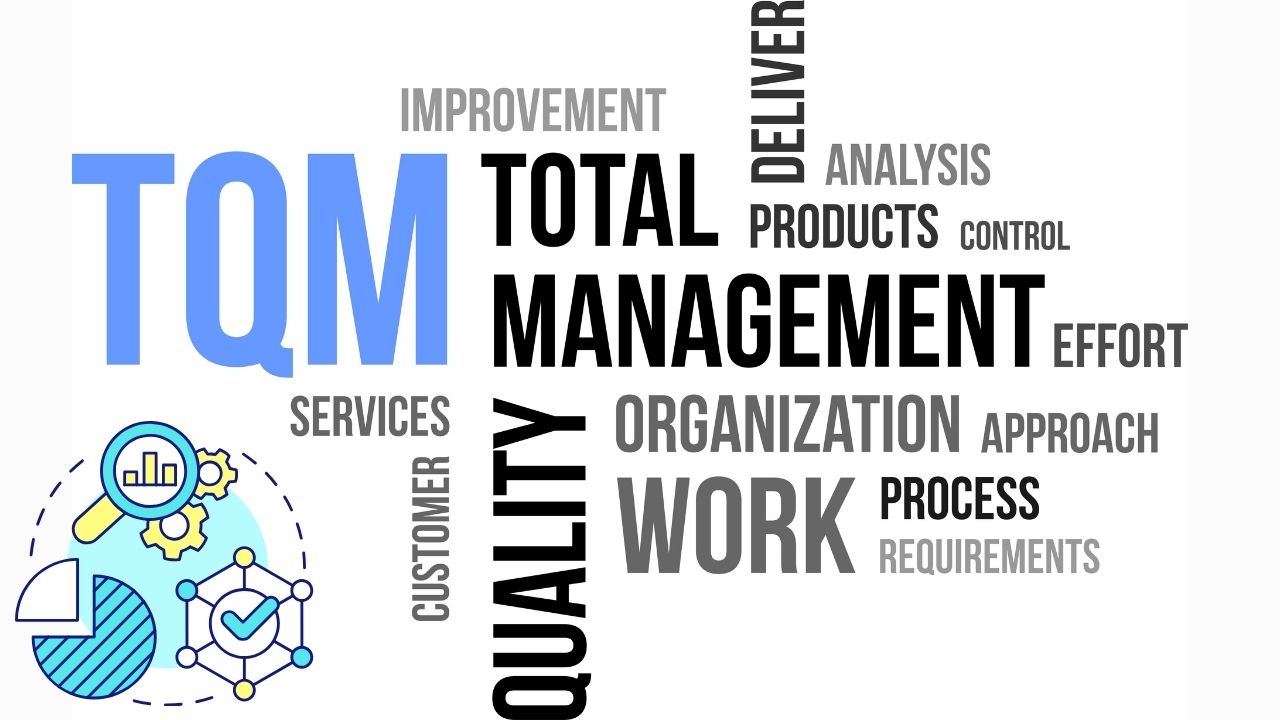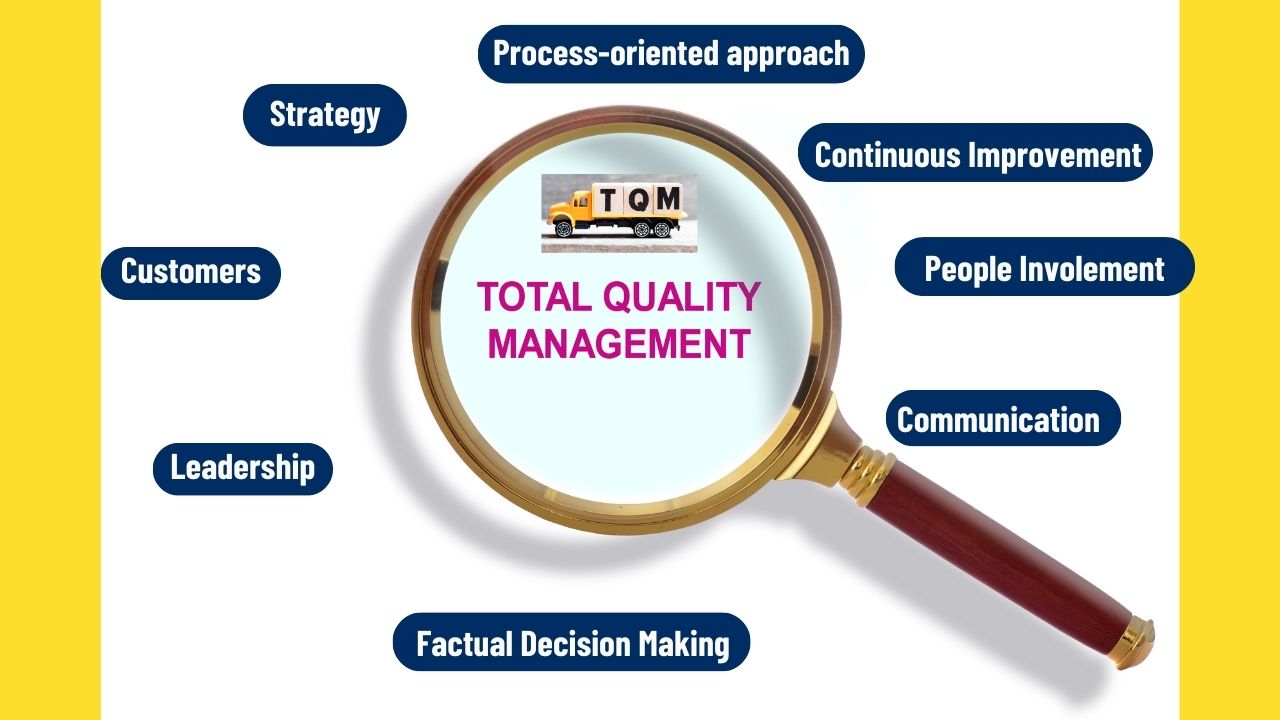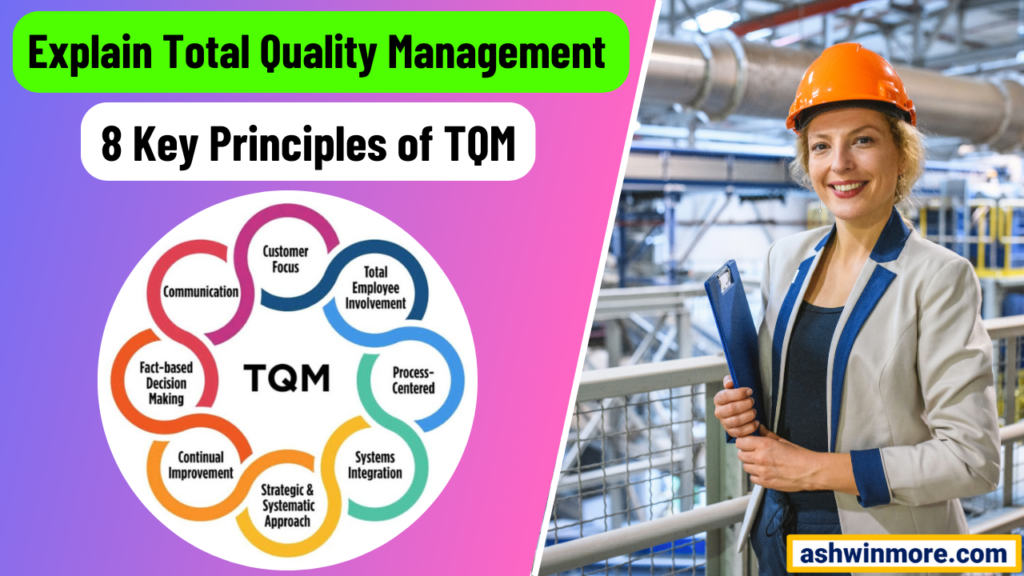Total Quality Management is the holistic approach that not only promises quality but also continuous improvement in the organizations. It’s a powerful philosophy that positively affects every part of the organization from the meeting room to the actual shop floor.
Total Quality Management promotes a proactive approach to quality management which ensures that every employee in the organization is a stakeholder in the pursuit of achieving world-class quality in the products or services.
In this article, I will discuss TQM in detail along with its 8 key principles that drive transformative change in the organization, we will also understand how to implement TQM with simple steps and the benefits of this powerful philosophy.
So, Are you ready to streamline operations with the power of Total Quality Management? then let’s get started
What is Total Quality Management?
Customer satisfaction is what drives an organization’s long-term success if your customers are satisfied with the products/services you are offering then your organization will dominate the market and grow exponentially.
All this happens when an organization delivers consistent quality products and services to the customers. I am sure, you heard of world-class Japanese companies like Toyota, Sony, Pansonic, etc, these top companies didn’t become world-class by luck or accident,
They successfully implemented Total Quality Management and TQM not only made these companies good but also made them world-class and exceptional globally. TQM starts with a simple idea i.e. Quality is everyone’s responsibility.
TQM is more than just a management approach, it is a philosophy that believes in one thing: quality is not just about producing products without defects, it is about a complete mindset and cultural shift of organization.
It is about doing everything you do from top management to shop floor workers with the relentless pursuit of excellence at every level of the organization. Simply understanding every process, task, and minor detail is an opportunity to make things better.

8 Principles of Total Quality Management
TQM is guided by a set of 8 important principles that act as foundation pillars for the successful implementation of this powerful philosophy in your organization. Let’s understand all these principles of Total Quality Management one by one.

1. Customer focus:
The customer is the center of TQM implementation. It focuses more on understanding the customer needs, expectations, and feedback. Use that information to deliver products and services that meet or exceed those customer expectations.
When you understand the customer better you deliver high-quality products consistently to them and that increases customer satisfaction. Focusing on fulfilling customer’s needs and requirements helps organizations build and maintain strong customer relationships.
2. Involvement of people:
All the people working in any organization are actually the most valuable resources of that organization. TQM believes that any organization becomes successful becasue of the contribution of the people working there.
That’s why during TQM implementation, the involvement of all the employees is encouraged becasue everyone working in the organization has valuable insights and ideas to contribute to the improvement of the process and quality.
When employees are encouraged, they are more likely to work together and strive for continuous improvement and then everyone in the organization works toward one common goal i.e. Quality improvement.
3. Leadership:
In order to implement TQM successfully top management and leadership support is essential. Leaders should support and empower all the employees of the organization to contribute to the organization’s quality goals.
Leaders should set the vision and direction for the organization, create a culture of quality, and provide the necessary resources and support for quality improvement initiatives like Lean, PDCA, Six Sigma, etc.
4. Process-oriented approach:
Process-oriented thinking is the core of Total Quality Management implementation. TQM sees organizations as a series of interconnected processes and focuses on optimizing as well as improving processes instead of just single tasks or activities.
The process-oriented approach simply involves identifying the key processes, analyzing them with the help of tools like process mapping, and continuously finding ways to streamline and enhance them. By improving processes organizations increases overall efficiency.
5. Systematic and Strategic approach to management:
TQM focuses on the systematic and strategic approach to managing the organization, where all the decisions are based on data and facts instead of intuition. This approach helps identify and address the root causes of process-related problems.
A systematic and strategic approach means defining objectives, creating strategic plans, setting and measuring performance indicators, analyzing them properly, and making informed data-based decisions for problem-solving and continuous improvement.
6. Continuous Improvement:
Continuous improvement of the processes and products is the ultimate aim of Total Quality Management becasue that is what going to increase customer satisfaction. For that Organizations use tools like Lean Six Sigma, PDCA cycle, 8D problem-solving, etc.
During TQM implementation, organizations are encouraged to continually seek opportunities to improve processes, products, and services. This involves ongoing measurement, analysis, and a feedback loop for making incremental and significant improvements.
7. Fact-based Decision making:
TQM emphasizes the use of data and facts to make decisions rather than assumptions. Organizations must use data-driven decision-making in order to implement TQM successfully.
Data-driven decision-making helps organization ensures that improvement actions are based on accurate information/data, which lead to more effective decision-making and increases the chances of achieving desired results.
8. Communication:
TQM implementation is not possible without proper communication between customers, all levels of employees, and stakeholders (like suppliers). Proper communication helps organizations build strong relationships with everyone.
Another purpose of proper communication in TQM is that all the important information should flow freely from top management to all levels of employees in the organization. When employees are aware of the organization’s quality goals, they contribute effectively to achieve those goals.
How to implement TQM?
There is no standard process to implement Total Quality Management, it actually depends on organization to organization. So you must create a Standard step-by-step process that suits your organization.
While implementing TQM always think from your organization’s point of view. Here I am going to share some standard checklist steps that you can check and refer to while implementing TQM at your organization.
- It starts with the strong commitment of top management and leadership toward TQM. They should establish a clear vision, mission, and goal for TQM implementation and be actively involved in the implementation process.
- Form a proper cross-functional team that includes members from different departments of the organization. Assign one member as a team leader who can lead and the entire team is responsible for planning, and monitoring the TQM implementation activities.
- Develop a clear and proper quality policy that aligns with your organization’s values and objectives. This policy should reflect a commitment to meeting customer needs and consistent quality improvement.
- Work on understanding customer needs, requirements, and expectations. Collect customer data using surveys, focus groups, interviews, or direct communication on call.
- Train all the team members or other employees as well on the principles and tools of TQM. Make sure that they should participate actively in the process quality improvement initiatives.
- Identify all the important processes in the organization and map them using process mapping to understand how they work. Study these processes and analyze their performance for efficiency and quality.
- Define clear and measurable quality objectives or KPIs for each department and process. These quality objectives must be aligned with the organization’s overall quality goal. You can track TQM efforts progress using these KPIs.
- Collect data related to the important process you initially identified and quality metrics. You can analyze this data using statistical tools and techniques to identify areas for improvement.
- Start building a culture of continuous improvement. Encourage everyone to find and address process problems on a regular basis no matter how small the problem is. Motivate everyone to contribute consistently to quality improvement.
- Encourage everyone to suggest and implement improvements in their respective work areas. Ask them to use tools like the PDCA cycle, Six Sigma, and Lean thinking to drive continuous improvement initiatives.
- Whether you are a manufacturing or service organization, work closely with suppliers to ensure they meet the required quality standards. Maintain good relationships with suppliers to improve the quality of inputs (like raw materials).
- Think of benchmarking by comparing an organization’s performance with the industry’s best practices. Identify areas where organizations can excel or need improvement.
- Develop and maintain standardized procedures and work instructions to ensure consistency and quality in the processes. Make sure that these documents are easily available to everyone in the organization for learning purposes.
- To check the effectiveness of TQM implementation throughout the organization, think of conducting regular audits to review the organization’s progress, and make necessary adjustments if needed.
- In order to get the overall best results of TQM implementation, you can integrate Total quality management principles into all aspects of the organization like strategic planning, budgeting, and management-level decision making.
- Throughout the TQM implementation journey, make sure leaders recognize and celebrate the achievements or milestones, no matter how small it is. This initiative inspires everyone to contribute more towards the Total Quality Management implementation.
- Lastly, remember TQM implementation needs long-term commitment. Don’t think of it as a short-term improvement project. You need to work on making consistent improvements and adapting to new changes.
Benefits of TQM
- TQM places a strong emphasis on understanding and meeting customer requirements by consistently delivering high-quality products and services to them and when organizations do this consistently they build trust and relationships with customers.
- It focuses on identifying, addressing, and preventing defects or errors in the products and services. This leads to a higher level of quality and reduces the need for rework or repair hence lowering the cost of poor quality.
- TQM implementation streamlines operations, reduces waste and eliminates process bottlenecks. It basically optimizes the processes and improves the overall efficiency. This leads to increased productivity and reduced operational costs.
- TQM believes that quality is everyone’s responsibility so it encourages the active involvement of employees in the decision-making and problem-solving work. When employees are encouraged they contribute positively towards achieving organizational quality goals.
- It also fosters a culture of continuous improvement where employees are encouraged to suggest and implement changes to enhance quality and process efficiency. This leads to more innovation in the organization and adaptation to market changes.
- As TQM relies on data for decision-making, with its implementation organizations gather and analyze process performance-related data and this data helps organizations identify areas of improvement and make data-driven decisions.
- Total quality management encourages strong leadership at all the levels of organization and promotes teamwork. This fosters collaboration among employees, departments, and management to work towards achieving quality goals.
- It is a long-term approach to achieving and maintaining quality excellence. It instills a commitment to continuous improvement and sustainable business practices which helps the organization thrive over time.
Conclusion
Don’t just consider Total Quality Management as a business strategy because it is a lot more than that. It is the philosophy that can elevate an organization to new heights of quality excellence. It’s a quality mindset that empowers every individual to be a quality advocate.
The 8 principles of Total Quality Management are the main pillars of this philosophy that instill a culture of quality, innovation, and adaptability in an ever-evolving marketplace. To implement this successfully in the organization, all the employees and leaders should work together.
When you integrate these 8 principles of TQM into your organization you build trust not only with your customers but also within your team and then you build a workplace where achieving quality is not just a goal it becomes a way of life.
If you found this article useful then please share this in your network and subscribe to get more such articles every week.






Total quality Contrl was founded bij the founder, who was an American. if applied properly it can be a win-win for everyone.